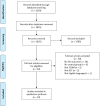The Impact of Physical Activity on Glycemic Variability Assessed by Continuous Glucose Monitoring in Patients With Type 2 Diabetes Mellitus: A Systematic Review
- PMID: 32903679
- PMCID: PMC7438766
- DOI: 10.3389/fendo.2020.00486
The Impact of Physical Activity on Glycemic Variability Assessed by Continuous Glucose Monitoring in Patients With Type 2 Diabetes Mellitus: A Systematic Review
Abstract
Aim: Patients with Type 2 Diabetes Mellitus (T2DM) have increased risk of developing vascular complications due to chronic hyperglycemia. Glycemic variability (GV) has been suggested to play an even more important role in the risk of developing diabetic complications than sustained hyperglycemia. Physical activity (PA) has shown reducing effects on mean plasma glucose; however, the effect on GV in T2DM needs further description. The objective of this review is to evaluate the effect of PA on GV, assessed by continuous glucose monitoring (CGM) in people with T2DM. Methods: A systematic literature search was conducted on MEDLINE and Embase to find randomized controlled trials (RCTs) covering the aspects T2DM, PA, and CGM. Following eligibility screening, variables of population characteristics, PA interventions, and GV outcomes were extracted and processed through qualitative synthesis. Risk of bias (ROB) was assessed using Cochrane ROB tool v2.0. Results: Of 1,825 identified articles, 40 full texts were screened. In the ten included RCTs matching the eligibility criteria, sample sizes ranged from nine to 63, mean age from 51 (SD 11) to 65 (SD 2) years and mean T2DM duration from four (SD 3) to ten (SD 6) years. Eight RCTs examined GV following single bouts of exercise, while two RCTs examined GV following training interventions. One RCT applied parallel group design, while nine RCTs applied crossover design. Numeric reductions in GV following acute exercise were seen, with four RCTs reaching statistical significance. Numeric reductions in GV were seen following training interventions, with one RCT reaching statistical significance. Numeric reductions of GV after PA appeared independently of intensity and T2DM progression but higher in participants with high baseline HbA1c and GV than with low. 80% of the trials were evaluated as uncertain/high ROB. Conclusion: The systematic literature search revealed limited and biased evidence showing that acute PA numerically reduced GV in patients with T2DM. PA reduced GV independently of PA intensity and T2DM progression. Prolonged RCTs with low ROB are needed to confirm reducing effects of PA on GV and to assess the influence of patient- and intervention characteristics on the effect of PA on GV.
Keywords: continuous glucose monitoring; diabetes mellitus; exercise; glycemic control; glycemic variability; physical activity; randomized controlled trials (RCT); type 2 diabetes.
Copyright © 2020 Bennetsen, Feineis, Legaard, Lyngbæk, Karstoft and Ried-Larsen.
Figures
Similar articles
-
Study of Glycemic Variability in Well-controlled Type 2 Diabetic Patients Using Continuous Glucose Monitoring System.J Assoc Physicians India. 2024 Jan;72(1):18-21. doi: 10.59556/japi.71.0441. J Assoc Physicians India. 2024. PMID: 38736069
-
Effectiveness of Continuous Glucose Monitoring on Metrics of Glycemic Control in Type 2 Diabetes Mellitus: A Systematic Review and Meta-analysis of Randomized Controlled Trials.J Clin Endocrinol Metab. 2024 Mar 15;109(4):1119-1131. doi: 10.1210/clinem/dgad652. J Clin Endocrinol Metab. 2024. PMID: 37987208
-
Effects of Continuous Glucose Monitoring on Metrics of Glycemic Control in Diabetes: A Systematic Review With Meta-analysis of Randomized Controlled Trials.Diabetes Care. 2020 May;43(5):1146-1156. doi: 10.2337/dc19-1459. Diabetes Care. 2020. PMID: 32312858
-
CGMS and Glycemic Variability, Relevance in Clinical Research to Evaluate Interventions in T2D, a Literature Review.Front Endocrinol (Lausanne). 2021 Sep 9;12:666008. doi: 10.3389/fendo.2021.666008. eCollection 2021. Front Endocrinol (Lausanne). 2021. PMID: 34566883 Free PMC article. Review.
-
Continuous Glucose Monitoring: A Review of Recent Studies Demonstrating Improved Glycemic Outcomes.Diabetes Technol Ther. 2017 Jun;19(S3):S25-S37. doi: 10.1089/dia.2017.0035. Diabetes Technol Ther. 2017. PMID: 28585879 Free PMC article. Review.
Cited by
-
Continuous glucose monitoring for automatic real-time assessment of eating events and nutrition: a scoping review.Front Nutr. 2024 Jan 8;10:1308348. doi: 10.3389/fnut.2023.1308348. eCollection 2023. Front Nutr. 2024. PMID: 38264192 Free PMC article.
-
An integrative profiling of metabolome and transcriptome in the plasma and skeletal muscle following an exercise intervention in diet-induced obese mice.J Mol Cell Biol. 2023 Aug 3;15(3):mjad016. doi: 10.1093/jmcb/mjad016. J Mol Cell Biol. 2023. PMID: 36882217 Free PMC article.
-
Diet and Physical Activity as Determinants of Continuously Measured Glucose Levels in Persons at High Risk of Type 2 Diabetes.Nutrients. 2022 Jan 15;14(2):366. doi: 10.3390/nu14020366. Nutrients. 2022. PMID: 35057547 Free PMC article.
-
Associations Between Device-Measured Physical Activity and Glycemic Control and Variability Indices Under Free-Living Conditions.Diabetes Technol Ther. 2022 Mar;24(3):167-177. doi: 10.1089/dia.2021.0294. Epub 2021 Dec 14. Diabetes Technol Ther. 2022. PMID: 34648353 Free PMC article.
-
The Effects of Accumulated Versus Continuous Exercise on Postprandial Glycemia, Insulin, and Triglycerides in Adults with or Without Diabetes: A Systematic Review and Meta-Analysis.Sports Med Open. 2022 Jan 24;8(1):14. doi: 10.1186/s40798-021-00401-y. Sports Med Open. 2022. PMID: 35072806 Free PMC article.
References
-
- Davies MJ, D'Alessio DA, Fradkin J, Kernan WN, Mathieu C, Mingrone G, et al. Management of hyperglycemia in type 2 diabetes, 2018. A consensus report by the american diabetes association (ADA) and the European association for the study of diabetes (EASD). Diabetes Care. (2018) 41:2669–701. 10.2337/dci18-0033 - DOI - PMC - PubMed




